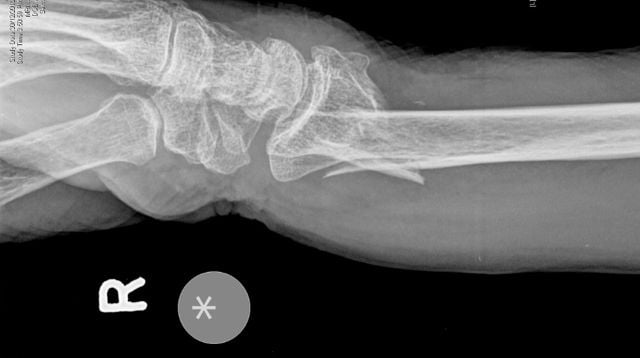by Ray Jongs, Hand Physiotherapist
A break of the wrist is most commonly a result of a fall onto the outstretched hand. This could result in a very painful wrist which slightly swells, or an extremely painful wrist that is bent to the shape of a dinner-fork, a Colles fracture.
Following a break of the wrist, the initial management is always a very hectic time in the patient's life. Commonly, this begins with a visit to the local doctor, who will invariably refer it to a specialist in an emergency department of a hospital. Following a series of x-rays, the specialist then needs to discuss the possibility of an operation if indicated. And lastly, the physiotherapist is notified to apply a resting plaster-of-paris slab to the wrist. From a physiotherapist’s perspective, the initial cast is only the beginning...
When the resting slab (usually made of plaster of paris) is put on, it is important that the arm is not thought of as an excommunicated part of the body. The slab is placed on the wrist to hold the fracture still, which in turn ensures comfort and aids healing. Importantly, the fingers, thumb, and elbow should not be hindered. As such, it is vitally important that other parts of the arm do not develop any problems; movement of the fingers, thumb, elbow and shoulder should be maintained regularly during the day between extended periods of elevation for the wrist.
Regardless of the initial management of the wrist, there are residual issues with flexibility and strength. These ultimately affect how the hand and arm are used.
For improving the flexibility, the mainstay of physiotherapy lies with exercises and advice. The exercises initially are directed at the range of motion of the wrist in specific directions, and may involve both moving the wrist and hand, together with stretching the wrist and hand.
A session with a physiotherapist is important for the giving of advice. Advice is crucial in alleviating the concerns of the patient or informing them of the usual course of rehabilitation for a break of the wrist, and the advice and education is aimed at reducing the problems caused by heightened anxiety or continued shielding of the hand and arm for day to day activities.
Physiotherapists, and in particular, hand physiotherapists may also employ other techniques aimed at increasing flexibility and strength: mobilising/manipulating the wrist; heating modalities of ultrasound or hot-packs; ice; free-weights; putty; items around the house - all these techniques aim to restore flexibility and strength. In addition, the disability caused by a break of the wrist may cause overuse of other areas, and physiotherapy is well equipped to monitor for and address these issues.
If you’ve suffered a dinner-fork or Colles fracture, did you have physiotherapy after the plaster of paris was removed?
Ray Jongs is a hand physiotherapist. He works at Royal North Shore Hospital and at BJC Health. BJC Health provides coordinated, comprehensive, and colocated multidisciplinary care to achieve effective solutions for patients. We call this model of care, Connected Care. Our clinics are located in Parramatta, Chatswood and Brookvale. Contact us.
This blog focuses on musculoskeletal disease, healthcare in general, and our Connected Care philosophy. Read More.
Stop Press: For Physiotherapists only. Attend the BJC Health Professional Development Seminar on February 20, 2011. Register to attend and link or join the professional page on Facebook. Our Hootcourse will also be online soon. Details on Facebook.



